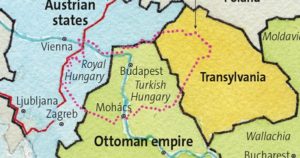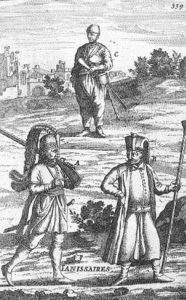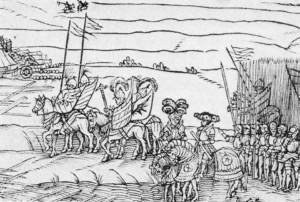19 July 1580 The victory at Nádudvar
During the so-called “small war” between the Ottomans and the Hungarians along the 1,000-mile-long Borderland, many raids and ambushes took place. On one hand, “softening up” the enemy’s hinterland has always been a very successful Ottoman military tactic because the villages around the Hungarian castles got depopulated and the fortifications were cut off from their supply lines. The peasants perished or fled, and the garrison got isolated and starved. Spreading terror and havoc was working well. However, the Ottoman raiding units often ran into the traps of Hussar cavalrymen. These units were equally mobile but they had larger horses and heavier armor than the Ottomans, and unlike the enemy, after 1572 they were supplied by pistols, too.

Let us not forget that the Hungarian light cavalry units sent raiding parties to the “Turk” territories to burn, plunder, and collect booty. Of course, the “Turk” lands were the Occupied Lands of Hungary, and the enemy’s conquest was not really accepted by the local peasants. They sent their taxes (sometimes just a symbolic sum or a pair of boots) to their landlords who had long ago fled to northern or western Hungary. At the same time, their lords never gave up their ownership and sent their men to collect taxes whenever they could. Was it greed, or resistance? Anyway, the attitude of ignoring borders (or regarding them as just temporary lines) saved Hungary to survive the 150-year-long partition. Think about it.

As we said, the Hussars tried to collect taxes from the Hungarian villages controlled by the Turks. (Note: the mercenaries hired by the Ottomans, the ones who guarded their castles in the Occupied Lands of Hungary were not Turkish at all. According to their payrolls, 96% of them were Albanians, Serbians, or other South Slavic people.) If the local peasants did not cooperate, the Hussars took away what they needed. If the judge of the village cooperated, the returning Turks had him impaled or skinned alive. The whole sorrowful situation derived from the fact that the Hungarian soldiers were not regularly paid by the Habsburg king and they had to prevent starvation by raiding the countryside controlled by the enemy. Eventually, it was how the famous Hussar warfare was developed. More about Hussars:
https://www.hungarianottomanwars.com/essays/horses-in-the-battle-of-mohacs/
The “small war” limited military actions to smaller clashes where cannons were not allowed to be used and serious sieges were forbidden, just like duels. As a rule, the Habsburg king received a part of the booty and turned a blind eye to the complaining Ottomans – when the fight was victorious. However, the king scolded the “violators of the truce” if the Hussars got defeated, and even imprisoned the commanders for a few days…You can read about dozens of similar raids and ambushes on my page – these nameless fights kept the expanding Ottoman Empire at bay and saved the western part of Europe from getting invaded. However, the inhabitants of Hungary (Hungarians and non-Hungarians alike) paid a very high price for this.

Before the victory of Nádudvar, a series of events had taken place. One of the favorite hit-and-run actions of the Hussars was ambushing great agricultural fairs. The warriors of Ónod, Eger, and Szatmár castes succeeded in attacking the fair of Hatvan city on 21 April 1580 where they gained a huge booty and captured many high-ranking Turks. Ransom was one of the most important incomes. We know that the famous Hungarian warrior poet, Balassi Bálint was among the ambushers at Hatvan. (Please, note that I use the Oriental name order for Hungarians where family names come first.) You can read more about this event on my page:
https://www.hungarianottomanwars.com/1541-1699/the-hussars-ambush-the-fair-of-hatvan-in-1580/

The case of Hatvan’s fair was a scandal for the Ottoman beys, and they used this event to report Pasha Kara Üvejsz of Buda to the sultan because they all hated the pasha heartily. As a result of this, the pasha was removed from his office. Note, the pasha of Buda was a very high rank in the Ottoman Empire, perhaps only the Grand Vizier was above him. The Bey of Szolnok was the main figure in the removal of the pasha, his name was Sehszüvár (Sásvár) bey. He was a Hungarian renegade and his desire was to become the pasha of Buda by all means. As it was, Pasha Kara Üvej was so much disliked by the beys because he tried to collect more taxes for the Treasury and in order to achieve it, he needed peace. He was hindering the Ottoman raids against Royal Hungary. We know that Sehszüvár bey was one of the Ottoman beys who always went raiding whenever he could. He had a wicked reputation, you can read more about his life here:
https://www.hungarianottomanwars.com/essays/bey-sasvar-the-renegade/






Dear Readers, I can only make this content available through small donations or by selling my books or T-shirts.
If you like my writings, please feel free to support me with a coffee here:
You can check out my books on Amazon or Draft2Digital, they are available in hardcover, paperback, or ebook:
https://www.amazon.com/dp/198020490X
or at https://books2read.com/b/boYd81


My work can also be followed and supported on Patreon: Become a Patron!http://Become a Patron!


https://hungarianottomanwars.myspreadshop.com/

https://hungarianottomanwars.myspreadshop.com/all

